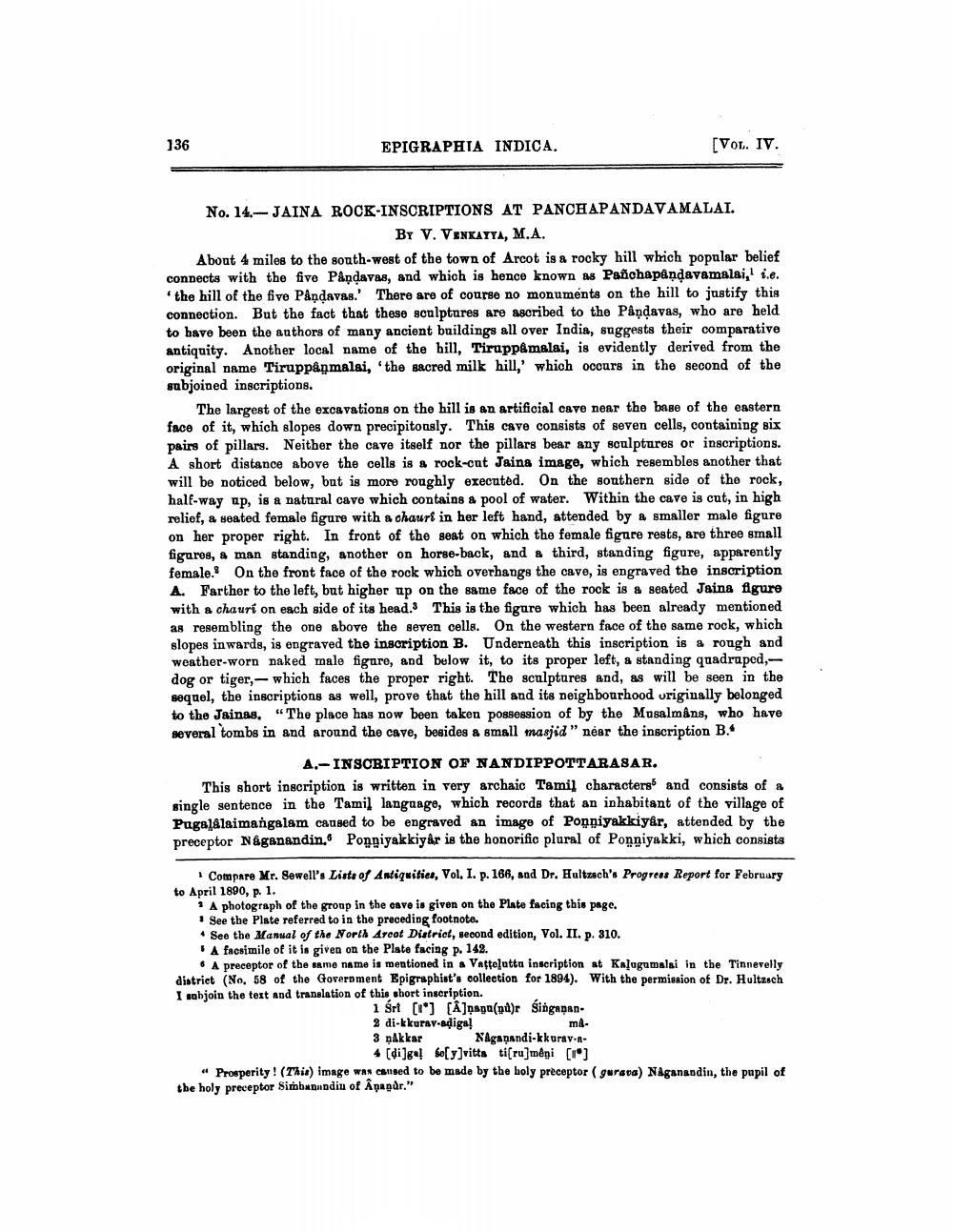________________
136
EPIGRAPHIA INDICA.
[Vol. IV.
No. 14.-JAINA ROCK-INSCRIPTIONS AT PANCHAPANDAVAMALAI.
BY V. VENKATTA, M.A. About 4 miles to the south-west of the town of Arcot is & rocky hill which popular belief connects with the five Pandavas, and which is hence known as Panohapandavamalai, i.e.
the hill of the five Pandavas. There are of course no monuments on the hill to justify this connection. But the fact that these sculptures are ascribed to the Pandavas, who are held to have been the authors of many ancient buildings all over India, suggests their comparative antiquity. Another local name of the hill, Tiruppamalai, is evidently derived from the original name Tiruppanmalai, the sacred milk hill,' which occurs in the second of the subjoined inscriptions.
The largest of the excavations on the hill is an artificial cave near the base of the eastern face of it, which slopes down precipitously. This cave consists of seven cells, containing six pairs of pillars. Neither the cave itself nor the pillars bear any sculptures or inscriptions. A short distance above the cells is a rock-cut Jaina image, which resembles another that will be noticed below, but is more roughly executed. On the southern side of the rock, half-way op, is a natural cave which contains a pool of water. Within the cave is cut, in high relief, a seated female figure with a chauri in her left hand, attended by a smaller male figure on her proper right. In front of the seat on which the female figure rests, are three small figures, & man standing, another on horse-back, and a third, standing figure, apparently female. On the front face of the rock which overhangs the cave, is engraved the inscription A. Farther to the left, but higher up on the same face of the rook is a seated Jaina figure with a chauri on each side of its head. This is the figure which has been already mentioned as resembling the one above the seven cells. On the western face of the same rock, which slopes inwards, is engraved the inscription B. Underneath this inscription is a rough and weather-worn naked male figure, and below it, to its proper left, a standing quadruped, dog or tiger, which faces the proper right. The sculptures and, as will be seen in the sequel, the inscriptions as well, prove that the hill and its neighbourhood uriginally belonged to the Jainas, "The place has now been taken possession of by the Musalmans, who have several tombs in and around the cave, besides & small masjid " near the inscription B.
A.-INSCRIPTION OF NANDIPPOTTARASAR. This short inscription is written in very archaic Tamil characters and consists of a single sentence in the Tamil language, which records that an inhabitant of the village of PugalAlaimangalam caused to be engraved an image of Poppiyakkiyår, attended by the preceptor Någanandin. Poggiyakkiyêr is the honorific plural of Ponniyakki, which consists
Compare Mr. Sewell's List of Antiquities, Vol. I. p. 166, and Dr. Haltzsch'. Progress Report for February to April 1890, p. 1.
A photograph of the group in the cave is given on the Plate facing this page. * See the Plate referred to in the preceding footnote.
See the Manual of the North Arcot District, second edition, Vol. II. p. 310. "A facsimile of it is given on the Plate facing p. 142.
6 A nranantor of the same name is mentioned in a Vattelutta inscription at Kalogumalsi in the Tinnevelly district (No. 58 of the Government Epigraphist's collection for 1894). With the permission of Dr. Hultzsch I sobjoin the text and translation of this short inscription.
1 śrt [t'] [A]nagu(nů) singanan 2 di-kkuray-adiga!
m . 3 Akkar Nagapandi-kkurav-A
4 [di]ge! fesy]vitts ti[ru]mêņi [1] « Prosperity! (This image was caused to be made by the boly preceptor (gurara) Naganandin, the pupil of the holy preceptor Simba undiu of Apaşar."




